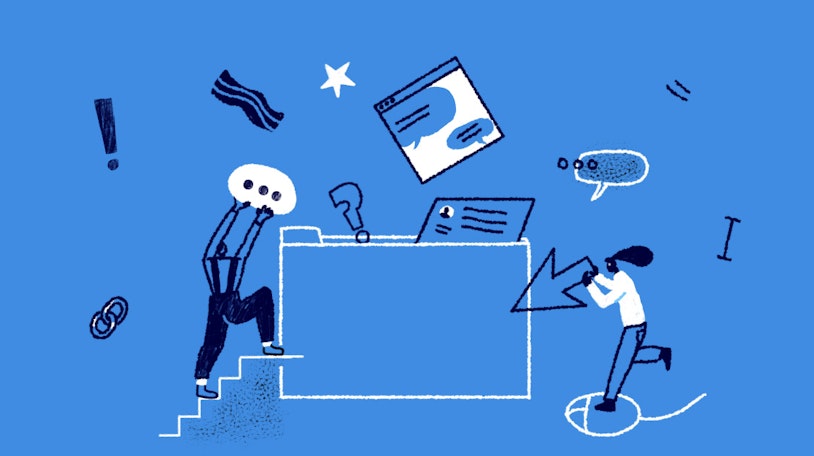Focusing solely on your product as a differentiator is simply not sufficient in competitive industries like ecommerce or software-as-a-service (SaaS).
If you want to stand out from your competition, you need to provide an exceptional customer experience.
Recent research from Forrester proves the point, showing that customer-oriented organizations grow 2.5x faster and retain twice as many accounts compared to companies with non-customer-centric strategies.
In this article, we’ll explore what it truly means to be customer-centric and go over actionable steps you can take to make your business more customer-focused.
What does it mean to be customer-driven?
Customer-driven businesses recognize the importance of customer experience, making it a top priority in their day-to-day operations. By placing customers at the core of decision-making processes and prioritizing their experiences over short-term profits, they lay the groundwork for consumer loyalty and trust, boosting business metrics in the long run.
Here are some notable examples of customer-oriented companies, although their customer focus has taken very different shapes:
Airbnb leverages a comprehensive Voice of the Customer (VoC) program to collect user feedback to enhance the quality of listings and address customer pain points promptly.
IKEA offers a powerful app that enables users to virtually place furniture in their living spaces and visualize how IKEA products can complement their homes before making a purchase.
Ritz-Carlton is known for its customer-driven service. Their staff goes above and beyond to assist customers, always with a friendly, proactive, and empathetic approach. Their commitment to exceptional service helps build strong customer relationships, turning hotel guests into loyal brand advocates.
Benefits of a customer-driven approach
While many product-led companies have achieved remarkable success in the market, there isn't a single business that wouldn't benefit from embracing a more customer-centric approach.
Let’s look at some of the primary advantages of a customer-driven approach in business.
Customer loyalty and improved retention rates
Increasing competition means that acquiring new customers is becoming more and more expensive. At the same time, PwC found that over 30% of customers are ready to leave a brand they love after a single poor experience.
By investing in exceptional customer experience, you can establish a strong foundation for loyal customer relationships, positively impacting your retention rates.
Increased customer lifetime value (LTV)
When customers develop loyalty toward your brand and trust your company, they are more likely to make repeat purchases. That means higher customer lifetime value.
By offering a stellar experience, you can also justify higher pricing in general — studies indicate that 66% of consumers are willing to pay more for a superior experience.
Business sustainability
Deloitte found that customer-centric companies are 60% more profitable compared to other organizations. By placing customers at the heart of your operations, you can pivot and evolve, ensuring that your solutions always align with customer needs. This, in turn, enhances the likelihood of long-term business sustainability and growth, especially when compared to focusing solely on product features, which can lead to a lack of market fit over time.
Adopting a customer-driven approach is undeniably helpful for any business. Now, how can you transform your organization into a more customer-centric one?
12 customer-driven strategies to grow a successful company
The good news is that you don’t have to make huge changes right away. Instead, you can take a step-by-step approach and adjust one thing at a time, driving positive improvements in customer experience over time.
Below, you’ll find twelve practical customer-driven strategies you can employ to prioritize customers and join the ranks of successful customer-obsessed companies like Starbucks, Shopify, and Apple as well as the ones listed above.
1. Support customers where they want it
When it comes to communication channels, customers can have different preferences based on their demographics and personal tastes. It’s important to consider the expectations of your audience and find out which channels they prefer.
For younger audiences, social media and chat support are often the way to go, while older customers may prefer phone calls or emails. If you’re in SaaS, complex technical issues are easier to handle via email or live chat, where customers can share screenshots or screen recordings.
If you offer support through multiple channels, using an omnichannel help desk can make your team’s life easier by enabling them to handle inquiries from different channels all in one place.
2. Provide prompt responses
The world is moving quickly and your customers expect swift replies when reaching out to your company. Make sure your team is equipped to provide timely responses that meet both industry benchmarks and customer expectations.
Across various channels, the benchmark for first response time (FRT) hovers around five hours.
Typically, customers anticipate replies within an hour for emails and social media messages and within a few minutes for phone calls and live chat. (Source)
| Channel | Target Response Time |
|---|---|
Email 💌 | 1 to 4 hours |
Live Chat 💬 | 0.5 to 1 minute |
Social Media 💻 | 1 to 2 hours |
Phone 📱 | 1 to 2 minutes |
3. Speed up issue resolution
When customers encounter problems with your product or service, they want them fixed ASAP. To decrease resolution times, you need to break down silos between departments and prioritize customer experience over KPIs and operational efficiencies of individual teams.
When customers report bugs and your tech team's KPIs are all focused on the speed of developing new features, they might not have the motivation to promptly address customer issues. This can lead to less than ideal customer experiences, even if your support reps are amazing.
4. Invest in self-service resources
If your team doesn’t have the capacity to provide around-the-clock customer support, invest in self-service resources such as help center content or chatbots, and empower customers to resolve issues quickly on their own. This approach is backed by recent studies reporting that 74% of users actually prefer using bots for simple queries.
5. Empower your employees to meet customer needs
Your customer-facing teams may come across opportunities to enhance customer experience by slightly deviating from company policies — for instance, by providing a complimentary upgrade or extending the trial period. By giving them the autonomy to make these decisions and prioritize customers’ best interests, you can take your customer experience to a whole new level.
For example, take inspiration from Ritz-Carlton's approach, where every employee is empowered to use up to $2000 to resolve a guest issue.
While your budget may not allow such extremes, allowing your team to incorporate surprise acts of hospitality and go the extra mile for customers (even if it means deviating from the standard policy) can truly make a difference.
6. Prioritize customer experience in marketing campaigns
While sending out ten emails per day may boost brand awareness and sales in the short term, it can also harm your deliverability rates and lead to people associating your brand with annoying messaging.
To avoid this, ensure that you reach out to customers at times when they expect to hear from you, and focus on delivering value rather than bombarding them with upgrade requests. Share content that is useful for your audience, positioning your brand as a thought leader in the industry — be it insights from research conducted by your company, helpful checklists, or benchmarks tailored to your audience’s interests.
Really Good Emails is a great inspiration source for developing a customer-driven marketing strategy.
7. Personalize your interactions
Whether it’s in marketing campaigns or when handling customer requests, ensure that your customer base is properly segmented. You need to fully understand and take into account each customer’s journey stage, service expectations, and goals when interacting with them.
The key customer information should also be easily accessible for your team members to use on the go in customer conversations and outreach campaigns.
8. Take all feedback as a gift
To meet customer expectations, you must have a good understanding of their needs and preferences. This process starts with collecting and analyzing customer feedback.
The most straightforward way to collect and analyze feedback is to pull Voice of the Customer (VoC) data from all available sources — including support tickets, customer calls, social media interactions, and public review sites — into a centralized platform and leverage AI tools like Kapiche or Qualtrics to extract key insights.
Thanks to advancements in AI technology, analyzing free-text feedback no longer requires weeks of manual effort. It can now be done in a matter of minutes with just a few clicks, so you can quickly sift through thousands of messages and understand customer sentiments, preferences, and concerns on a deeper level.
9. Take action on customer feedback
Of course, simply listening to customer feedback isn't enough — you have to act on it.
No matter how fantastic your customer-facing teams are, if your offering fails to meet the mark, your customers won't be satisfied. Take proactive measures based on their feedback, and make necessary adjustments to continuously enhance customer experience.
While suggestions related to service level and feature requests require thoughtful prioritization, and you understandably can't bring everything under the sun to fruition, reported product defects must be addressed promptly.
10. Facilitate interactions between the product team and customers
Whether through customer visits, all-hands support initiatives, or customer interviews, teams traditionally positioned in the back end must have direct interactions with customers to hear about their pain points firsthand and develop empathy for their struggles.
It’s especially critical for product teams developing your offering. While product analytics and user feedback are great for data-driven decision-making, they can’t beat face-to-face interactions with customers for deeply understanding customer needs and concerns.
11. Implement customer loyalty programs
Loyalty programs are great for rewarding repeat customers with special offers, discounts, and other incentives encouraging them to come back.
With 70% of U.S. consumers ready to stick with companies that have proper loyalty programs in place, this can significantly boost your average customer LTV while keeping customer needs in focus.
12. Conduct churn analysis
If you’re running a subscription-based business, every customer represents a risk of churn. Your job is to determine why customers leave and to analyze the data to enhance your offering and meet the expectations of your remaining customer base.
When analyzing churn data, focus on:
Identifying which customers are leaving and their initial goals when they first signed up — perhaps they weren't the right fit, and you need to adjust your ideal customer profile (ICP) to attract better-fitting customers.
Understanding why customers are leaving to identify areas for improvement.
Armed with this data, you can make the necessary changes to retain those customers who are still with you.
Empower your team to delight customers
The customer-driven approach is non-negotiable for sustained business success. As the costs of switching between products decrease, customers become more likely to churn if their experience isn’t a priority in your strategy.
Shifting company strategy toward a more customer-centric one goes beyond cultural adjustments. It requires equipping your customer-facing teams with tools for delivering exceptional experiences.
Investing in a customer-centric help desk solution like Help Scout can go a long way in fostering customer loyalty. Sign up for a free 15-day trial today, and discover a more customer-centric way to manage interactions with your audience.






